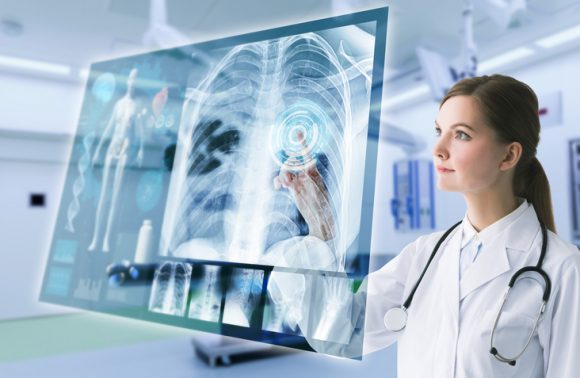Artificial Intelligence or “AI” has been in the headlines for months in a fleet of industries. FLASS decided it was now time to show you it is also working for pulmonologists. In this blog article, we are bringing you the latest research on Artificial Intelligence and Pulmonology, from Dr. Marko Topalovic (Ph.D.), a postdoctoral researcher at the Laboratory for Respiratory Diseases, Catholic University of Leuven (KU Leuven), Belgium.
Artificial Intelligence Research Study Presented at the European Respiratory Society
To determine the value of A.I. for diagnosis, Dr. Marko Topalovic (Ph.D.), set up a special lung function and diagnosis study. His premise was that “Pulmonary function tests provide an extensive series of numerical outputs and their patterns can be hard for the human eye to perceive and recognize…”

Diagnosis of lung diseases is a complex art and science.
Logically however we all know that it is an easy matter for computers to manage large quantities of data. Thus, Dr. Topalovic presumed pulmonologists might find AI to be an invaluable help in diagnosing respiratory symptoms.
A Research Study Empowered With an Artificial Intelligence and a Trained Algorithm
Let’s review the respiratory tests Dr. Topalovic trained his A.I. to understand. Together as a group, the tests are called “Pulmonary Function Tests (PFT):
- Spirometry.: This is a very simple, painless test in which the patient breathes through a mouthpiece. The instrument measures the amount of air inhaled and exhaled.
- Plethysmography.: This test also called a body box, enables your doctor to assess lung volume. It measures the pressure in a booth in which the patient is sitting and breathing through a mouthpiece.
- The Diffusion Capacity test. This test measures how well a patient’s lungs can transfer oxygen and carbon dioxide to and from the bloodstream. It examines the efficiency of the alveoli, which are the tiny air sacks in the lungs.
Phase I: Preparing “Dr.” Artificial Intelligence to Take a Look at Lung Patients’ Problems
Results from the PFT tests do not give doctors a diagnosis. They only list important information about the functioning of the patient’s respiratory system. Diagnosis requires careful and considered interpretation of the test results.
Building the Giant Data Set for Dr. A.I.
In the Topalovic study, the researchers used historical data from 1430 patients from 33 Belgian hospitals. Before Artificial Intelligence was set up, “The data were assessed by an expert panel of pulmonologists…” Then the experts measured their opinions against gold standard guidelines from the European Respiratory Society and the American Thoracic Society.

Artificial Intelligence is helping in medical research.
This group of specialists considered patients’ medical histories as well as the results of all PFTs and additional tests. Then they agreed on the correct interpretation and developed an official diagnosis for each patient.
This gave Dr. Topalovic a body of correct data which he could use like questions and answers, on which to train the algorithm and to test the AI.
“Dr.” Artificial Intelligence Makes the Rounds
Dr. Topalovic stated, “When training the AI algorithm, the use of good quality data is of utmost importance…”
“He used the above-mentioned data were to develop an algorithm to train the AI, before validating it by incorporating it into real clinical practice at the University Hospital Leuven.” The challenging part was to train the algorithm so it unmistakably recognized “patterns of up to nine different diseases.”
Phase 2: Testing, Validation, and Interpretation for “Dr.” AI
Then, 120 pulmonologists from 16 European hospitals (from Belgium, France, The Netherlands, Germany, and Luxembourg) made 6000 interpretations of PFT data from 50 randomly selected patients.
Dr. Topalovic exposed his Artificial Intelligence to the same data. Thus, “AI also examined the same data. The results from both were measured against the gold standard guidelines in the same way as during the development of the algorithm.”
So–Artificial Intelligence Gets His Unofficial “MD?”
The results were somewhat shocking.
1. The researchers found that the interpretation of the PFTs by the pulmonologists matched the guidelines in 74% of cases (with a range of 56-88%)…
2. However, the AI-based software interpretations perfectly matched the guidelines (100%). On the one hand, it was noted that the doctors were able to correctly diagnose the primary disease in 45% of cases (with a range of 24-62%). .On the other hand, the AI gave a correct diagnosis in 82% of cases.
Like a Proud Papa, Dr. Topalovic Proclaimed the Efficacy of the Machine

AI reveals new Studies that Point to Causes of COPD and Other Lung Diseases Not Previously Considered.
Dr.Topalovic said: “We found that the interpretation of pulmonary function tests and the diagnosis of respiratory disease by pulmonologists is not an easy task.”
- On the one hand, it takes more information and further tests for human doctors to reach a satisfactory level of accuracy.
- On the other hand, the AI-based software has superior performance and therefore can provide a powerful decision support tool to improve current clinical practice.
- Feedback from doctors is very positive, particularly as it helps them to identify difficult patterns of rare diseases.
“A New Question: How Do You Pay Dr. AI?
Dr. Topolovic’s greatest validation comes from the fact that “Two large Belgian hospitals are already using the AI-based software to improve interpretations and diagnoses.” He commented, “We firmly believe that we can empower doctors to make their interpretations and diagnoses easier, faster and better.”
A Glimpse at Dr. AI’s Future
In spite of some tongue-in-cheek teasing, AI will not replace doctors. This is because “doctors are able to see a broader perspective than that presented by pulmonary function tests alone. This enables them to make decisions based on a combination of many different factors.”
Conclusions Based on AI Performance
Then the research scientists added, “However, it is evident that AI will augment our abilities to accomplish more and decrease chances for errors and redundant work. The AI-based software has superior performance and therefore may provide a powerful decision support tool to improve current clinical practice.”

Artificial Intelligence Helps categorize and interpret Diagnostic tests.
This development might seem a little like science fiction, but it is actually happening now in many phases of human life.
As Dr. Topalovic puts it, “Nowadays, we trust computers to fly our planes, to drive our cars and to survey our security. We can also have confidence in computers to label medical conditions based on specific data.” He added, “The beauty is that independent of location or medical coverage, AI can provide the highest standards of PFT interpretation and patients can have the best and affordable diagnostic experience.”
Healing Power: AI, MD, and Divine
Doctors and staff at FLASS respect and admire the advances in science and research that bring us new technology. We eagerly embrace new techniques and methodologies which strengthen our abilities in diagnosis and healing.
Yet we caution our colleagues to remember that human intuition and human compassion are not algorithms nor elements of machine learning. We doubt these traits can be coded into any computer’s subroutines with current technology. Although 21st-century technology brings us great tools for healing, it is the humans who bring great healing. And likewise, if we might be so bold as to say it, sometimes we also acknowledge a power that goes beyond human or machine.

